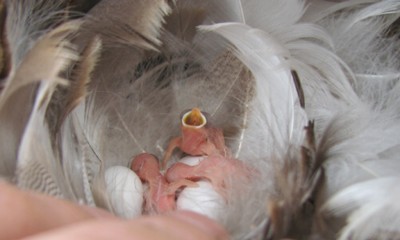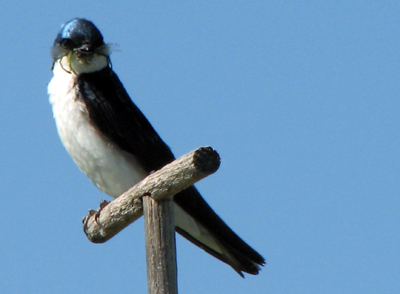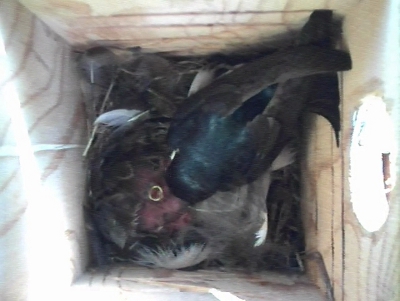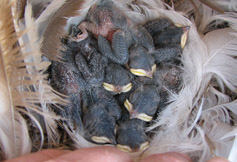ATTENTION: If you have a nestling that you believe is in trouble and needs human intervention in order to survive, here’s a procedure for Temporary care of Nestling Tree Swallows.
At Your Boxes:

Hatching is complete now in many boxes. Having small, completely dependent young instead of eggs presents your adult Tree Swallows with a different set of needs to meet. Now, suddenly, their lives must be focused on parental care of this new brood of small nestlings.
Concepts:
How do nestling songbirds let adults know they’re hungry?
- They beg, raising their heads and opening their bills to expose their colorful mouth linings. They wave their wings and heads, and make begging calls.
- Begging displays are critical because they give adults accurate information on the level of nestling hunger. The hungrier nestlings become the harder they beg. Begging displays also vary depending on nestling size, developmental stage, the number of nestmates, and how warm it is.
- Parents use begging behavior of their young to determine how often they bring food. If nestling begging rate, duration, and loudness increase, parents tend to increase food delivery accordingly, if they can.
- Begging involves both cooperation and competition among nestlings. Their combined displays stimulate parents to bring food to the brood. Their individual displays help determine which nestling a parent actually feeds on any given feeding visit.
- Research has found that nestlings that beg most intensely and most often, and those that position themselves in the center of the nest or directly under the entrance, consistently receive the most food.
- Feeding efforts of both parents are normally needed for most or all a brood’s young to survive the nestling period.
What do Tree Swallows feed their young?
- The same type of flying insects adults eat.
- Insects of the Order Diptera (flies) are especially important foods, but parents also feed their young Homoptera (leafhoppers), Hymenoptera (ants, wasps, bees), Odonata (dragonflies) and Coleoptera (beetles) when available.
- Nestling growth and survival depends heavily on the supply of flying insects adults can provide, which often depends in turn on the weather. Young swallows can starve during extended cold, wet, and/or windy weather.
- Research has also shown that survival is better when nestlings are fed insects from aquatic sources rather than terrestrial ones. They presumably offer more and/or better nourishment.
- Tree Swallows providing parental care for nestlings must hunt for food almost non-stop, dawn to dusk, from hatching until their young fledge. Female parents have the extra burden of brooding young when they are small.
Do Tree Swallows feed their young one insect at a time?
- No. Adults catch many prey per foraging trip. They hold them in a mass or “bolus” in their bill and throat (see below) for delivery to their young.
- Studies have found averages of between 19 and 34 prey per Tree Swallow bolus, with roughly 8,000 prey fed per brood per day.
- When nestlings are very small parents sometimes feed more than one young from a bolus. However, when they grow larger only one begging young normally gets fed per adult feeding visit.

Wouldn’t it be easier for the adults if they only had a few young to feed?
- Yes, and in actual nests with only a few young, nestlings tend to receive more food on average, and to grow faster and fledge sooner.
- However, adults with small broods may pass on fewer copies of their genes to future generations. Fewer young means lower reproductive output.
- More young means more work for adults, but their reproductive output is potentially higher.
- So there are trade-offs involved and no universal right number of young, except over evolutionary time spans.
Besides fuel and raw material supplied by adults through food, what other parental care do the small swallow nestlings need?
- Small young must have heat, lots of heat.
- Since they have high ratios of surface skin area to internal volume and few insulating feathers to keep heat in, small nestling bodies can lose heat very rapidly to the surrounding environment. They aren’t able to keep themselves warm, to “thermoregulate,” yet.
- The crucial job of keeping the small nestlings warm falls to the female parent, who “broods” them by covering them with the bare skin of the “brood patch” she used during incubation. This allows heat from her own body to pass to her young.
- In addition to keeping small nestlings from dying from hypothermia, brooding keeps nestling body temperatures high enough for the chemical processes of digestion and growth to continue working well.
- Some insulation for the nestlings also comes from the nest material and the way the nest cup is shaped and constructed.
- Here’s an in-box YouTube video showing how parent Tree Swallows care for their tiny, one-day-old nestlings. You’ll see the parents feed, remove waste, and brood the young, guard their box, and relieve each other.

Why do nestlings cluster tightly together? Are they just being friendly?
- Their “motive” is strictly instinctive. They are not “friends.” They are in fact competitors for the food the adults bring.
- Clustering helps each nestling reduce its heat loss by reducing the amount of each body’s surface exposed directly to the air. Cozying up to other warm bodies conserves one’s own heat.
- Clustering to retain heat is more effective in large broods.
- Females of nests with large broods can reduce brooding earlier since the larger total mass of the nestlings allows them to thermoregulate effectively as a group, and to maintain their own heat level at a younger age and smaller individual size.

What happens at night?
- Females remain in the nest overnight brooding smaller young until they are large enough to keep warm together as a group, using a combination of their individual metabolic heat, increasing feather insulation, and clustering to thermoregulate.
When does female parental care of nestlings stop including brooding?
- It depends on the weather, how many young are in the nest, and how fast they are growing. She can’t stop brooding until her nestlings can thermoregulate effectively.
- Cooler weather requires more intensive brooding.
- As nestlings grow their surface to volume ratio decreases, allowing better heat retention, plus their developing feathers start to have effective insulating value.
- It also becomes harder for females to cover their young with their bodies effectively as the young grow larger.
- By day seven or eight after hatching most females will have started reducing daytime brooding.
- Here’s a video showing a mother Tree Swallow’s brooding changes over time.
- Overnight brooding usually continues for several additional days.
- Once brooding has stopped neither adult spends much time inside the box.
- As she ceases to brood her nestlings the blood vessels in a female’s brood patch start to shrink, and her breast feathers begin to grow back.
Question for the next Topic: Sexing and Aging Tree Swallows
- How can you tell the sex and age of the parent swallows?
——————————————————————————–
Home: Tree Swallow Nest Box Projects
Creating Tree Swallow Nest Box Projects
Spring Return
Nesting Season Behavior
Song and Calls
Nest Site Claiming
Pair Formation
Nest Building
Bird Flight
Mating and Paternity
Diary of One Season at Salmon Creek
Monitoring Nest Boxes and Keeping Records
Making Box Checks Keeping Box Records Control Sheets Season Summaries Print Sheets
Banding Your Tree Swallows Banding Adults Banding Nestlings
Tree Swallows in Research Research Bibliography Glossary of Terms